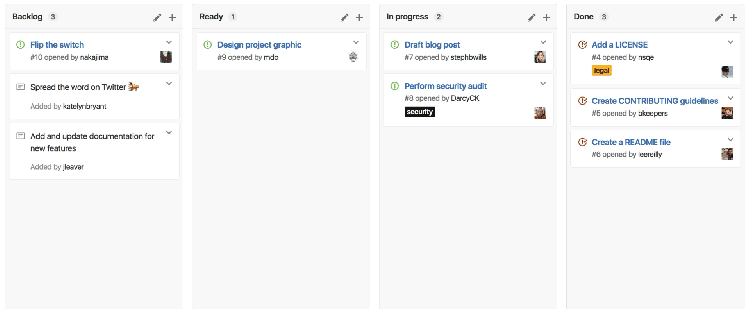At its GitHub Universe conference in San Francisco today, source code repository software startup GitHub is launching new features for developers, managers, and admins. Probably the most significant addition is a proprietary project-management tool for tracking pull requests, issues, and notes for repositories.
Right next to Code, Issues, and Pull Requests in each repository, there will be a new Projects tab. When you click it, you’ll see columns that you can customize and move around, and you can drag cards from one column to another to show progress.
Surely there are existing task-management services, like Asana and Trello, and more issue trackers, like Waffle.io and ZenHub, that GitHub could have integrated more deeply into its product. There are open source options that could have been implemented, too — recently GitHub competitor GitLab launched a new open source tool for visually managing issues. Atlassian has different versions of JIRA, and Microsoft’s Visual Studio offers Team Foundation Server. Now GitHub is making its move.
“I think we chose to build because we found that it was a commonly requested feature across open-source customers, our work customers, our personal customers — everyone was expecting it to be there and asking questions about why we didn’t have it,” Todd Berman, vice president of product engineering at GitHub, told VentureBeat in an interview.
The addition is significant because it broadens out GitHub’s capabilities. This Projects tool can be used for things other than managing issues. And sure enough, Berman said he and his wife have been using it to track things related to their house.
Also, now users’ profile pages have a new look, and they allow page visitors to instantly check out a given user’s first pull request, issue, and repository. The updates “contextualize a lot more of that who is a GitHub user and what are they doing,” Berman said.
Further, it’s also possible now for people to review incoming pull requests. People in charge can approve new ones or ask for changes. This feature integrates with GitHub’s protected branches, Berman said — if the reviewer requested changes to a pull request on a protected branch, the pull request can be blocked.

Above: Part of the new reviewing experience in GitHub.
Administrators are now able to require all users in their organizations to use two-factor authentication. And soon it will be possible for organizations to use SAML-based single-sign on (SSO) tools to manage all users. That feature will launch in beta in the next few months.
Also today, GitHub is opening up early access to an alpha version of the GraphQL application programming interface (API) that will allow third-party developers to build applications that use GitHub data that mirrors what GitHub uses to build its own products. That means more of GitHub’s online features, like reactions, will be exposed, to allow for richer third-party applications and less of a delay between when new features launch on github.com and when outside developers can build on top of those types of things, Berman said.
All these changes will be coming to GitHub’s Enterprise tier, Berman said.
Considered together, these changes sound reasonably smart. But Berman knows the company still has plenty of work to do. On mobile, for instance.
“We’re paying a lot of attention to mobile authoring and content creation,” he said.
GitHub cofounder and chief executive Chris Wanstrath’s blog post on the news is here.
VentureBeat's mission is to be a digital town square for technical decision-makers to gain knowledge about transformative enterprise technology and transact. Learn More

